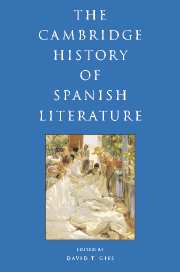Book contents
- Frontmatter
- I INTRODUCTION
- II HISTORY AND CANONICITY
- III THE MEDIEVAL PERIOD
- IV EARLY MODERN SPAIN: RENAISSANCE AND BAROQUE
- V THE ENLIGHTENMENT AND NEOCLASSICISM
- 17 Spain and Enlightenment
- 18 Eighteenth-century Neoclassicism
- 19 Eighteenth-century prose writing
- 20 Eighteenth-century poetry
- 21 Neoclassical versus popular theatre
- VI THE FORGING OF A NATION: THE NINETEENTH CENTURY
- VII THE MODERN, MODERNISMO, AND THE TURN OF THE CENTURY
- VIII TWENTIETH-CENTURY SPAIN AND THE CIVIL WAR
- IX IN AND OUT OF FRANCO SPAIN
- X POST-FRANCO SPANISH LITERATURE AND FILM
- Bibliography
- Index
- References
18 - Eighteenth-century Neoclassicism
from V - THE ENLIGHTENMENT AND NEOCLASSICISM
Published online by Cambridge University Press: 28 March 2008
- Frontmatter
- I INTRODUCTION
- II HISTORY AND CANONICITY
- III THE MEDIEVAL PERIOD
- IV EARLY MODERN SPAIN: RENAISSANCE AND BAROQUE
- V THE ENLIGHTENMENT AND NEOCLASSICISM
- 17 Spain and Enlightenment
- 18 Eighteenth-century Neoclassicism
- 19 Eighteenth-century prose writing
- 20 Eighteenth-century poetry
- 21 Neoclassical versus popular theatre
- VI THE FORGING OF A NATION: THE NINETEENTH CENTURY
- VII THE MODERN, MODERNISMO, AND THE TURN OF THE CENTURY
- VIII TWENTIETH-CENTURY SPAIN AND THE CIVIL WAR
- IX IN AND OUT OF FRANCO SPAIN
- X POST-FRANCO SPANISH LITERATURE AND FILM
- Bibliography
- Index
- References
Summary
The appeal to classicizing aesthetic principles which characterized the reformist tendency of high culture in eighteenth-century Spain is best understood as a reaction to the dominant literary mode inherited from the previous century. In drama, poetry, and prose writing the renewed emphasis on clarity of communication, respect for generic conventions, and the moral role of literature was thought best exemplified in the tradition deriving from Aristotle and Horace, and elaborated by European, including Spanish, theorists from the sixteenth century onwards.
In poetry the sixteenth-century classicism of Garcilaso, Boscán, Luis de León, and Herrera, and their successors the Argensolas, Esquilache, and Rebolledo, was widely admired, providing models to be imitated by eighteenth-century classicizers. Although printed texts of these predecessors were uncommon until their recuperation in new editions in the second half of the century, the works furnished models of a tradition identified with the revered poets of Augustan Rome (Horace, Ovid, Virgil). Authors such as Quevedo and Góngora, who sometimes abandoned classical clarity in works exploiting the intellectually complex metaphorical play of conceptismo and the erudite allusions of the culterano style, were nevertheless praised for compositions which coincided with classicism. The rhetoric of conceptismo still formed the mainstay of popular versifying, whose reliance on arguably unsubtle wordplay provoked condemnation by classicizers.
- Type
- Chapter
- Information
- The Cambridge History of Spanish Literature , pp. 307 - 313Publisher: Cambridge University PressPrint publication year: 2005



